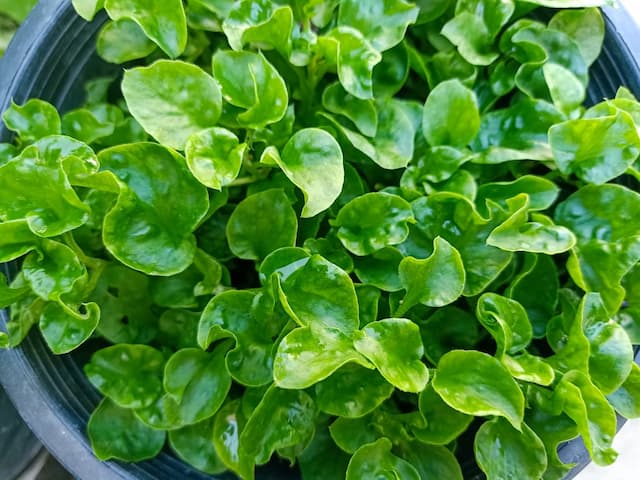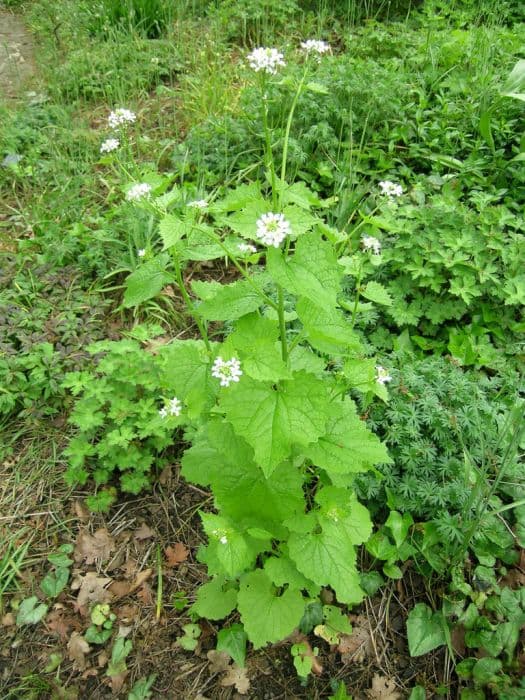Horseradish Armoracia rusticana

ABOUT
A. rusticana is a vigorous rhizomatous perennial with fleshy, pungently aromatic tap-roots, large, dock-like bright green leaves and panicles of small, white flowers in early summer
About this plant
 Names
NamesFamily
Brassicaceae
Synonyms
Horseradish, Red Cole, Mountain Radish, Great Raifort
Common names
Cochlearia armoracia, Armoracia lapathifolia, Rorippa armoracia, Nasturtium armoracia.
 Characteristics
CharacteristicsLife cycle
Biennials
Foliage type
Deciduous
Color of leaves
Green
Flower color
White
Height
2-3 feet (0.6-0.9 meters)
Spread
1.6 feet (0.5 meters)
Plant type
Herb
Hardiness zones
4-9
Native area
Southeastern Europe, Western Asia
Benefits
 General Benefits
General Benefits- Rich in Nutrients: Armoracia rusticana, commonly known as horseradish, is a source of vitamin C, dietary fiber, folate, calcium, and other minerals.
- Culinary Uses: Horseradish is used as a spicy condiment and flavoring agent for meats, sandwiches, and salads, enhancing food palatability.
- Garden Pest Deterrent: The strong aroma and compounds within horseradish have been used traditionally to deter garden pests.
- Companion Planting: Horseradish can be planted among potatoes and other crops to enhance growth and protect against certain diseases and pests.
- Soil Improvement: This deep-rooted plant can help to break up heavy soils and bring nutrients up to the surface for other plants to use.
 Medical Properties
Medical Properties- Antibacterial: Armoracia rusticana, commonly known as horseradish, contains compounds that may exert antibacterial effects.
- Diuretic: Horseradish has been historically used to promote increased urine flow.
- Expectorant: It may help in relieving respiratory conditions by helping to clear mucus from the airways.
- Anti-inflammatory: Some components in horseradish may help reduce inflammation.
- Circulatory Stimulant: The root is sometimes used to stimulate blood flow in herbal practices.
- Joint discomfort: Traditional use suggests horseradish may mitigate discomfort in joints due to its anti-inflammatory properties.
 Air-purifying Qualities
Air-purifying QualitiesThis plant is not specifically known for air purifying qualities.
 Other Uses
Other Uses- As a natural dye: The roots of horseradish can be used to produce a light brown dye for textiles.
- In enzymatic browning studies: Horseradish contains natural enzymes useful for scientific research on the browning process in foods.
- As a pest deterrent: The strong scent of horseradish can repel some pests in the garden when planted as a companion plant.
- Water purification: Horseradish can be used in constructed wetlands for treating water, as it helps in the breakdown of pollutants.
- Aquarium use: Small amounts of horseradish can be placed in aquariums as a natural method to combat certain fungal growth.
- Metal corrosion inhibitor: Certain compounds in horseradish have been studied for their ability to inhibit rust on steel.
- In culinary education: Horseradish provides a clear example of how enzymes affect flavor, and is used in sensory analysis in culinary schools.
- Photography: The juice of horseradish can be used as a primitive method for altering the tone of photographic prints.
- In art: Artists sometimes use horseradish juice to create natural, non-toxic paint for eco-friendly art projects.
- Cooking pot cleaner: The abrasive and enzymatic properties of horseradish root can be useful for scrubbing and cleaning burnt pots and pans.
Interesting Facts
 Feng Shui
Feng ShuiThe horseradish is not used in Feng Shui practice.
 Zodiac Sign Compitability
Zodiac Sign CompitabilityThe horseradish is not used in astrology practice.
 Plant Symbolism
Plant Symbolism- Resilience: Armoracia rusticana, commonly known as horseradish, has a strong and hardy nature, symbolizing the ability to withstand harsh conditions and recover from difficulty.
- Vitality: The pungent and spicy qualities of horseradish represent vibrant energy and the zest for life.
- Purification: Horseradish has been thought to possess purifying properties, symbolizing the cleansing of negative energy from one's surroundings.
- Protection: In folklore, horseradish was believed to have protective qualities, and it was used to ward off evil spirits or misfortune.
- Healing: Due to its medicinal uses, horseradish can symbolize healing, both physical and emotional.
 Water
WaterHorseradish (Armoracia rusticana) requires consistent moisture but should not be overwatered, as this can lead to root rot. Generally, watering should be done when the top inch of soil feels dry to the touch. Apply water until the soil is moist but not waterlogged, roughly 1 gallon per plant every week, depending on climate conditions and soil drainage. During hot, dry periods, you might need to water horseradish plants twice a week, while in cooler, wetter conditions, less frequent watering is required. Always ensure that the plant is in well-draining soil to prevent excess water from accumulating.
 Light
LightHorseradish prefers full sun conditions, meaning it should receive at least six hours of direct sunlight daily. It can also tolerate partial shade, but its growth and root development might not be as robust. The best spot for growing horseradish is in a sunny garden bed, although slightly shaded areas will suffice if full sun is not available. Avoid deeply shaded areas as this will hamper the plant's growth.
 Temperature
TemperatureHorseradish is a hardy plant that can withstand a wide range of temperatures, making it suitable for many climates. It can survive temperatures as low as 20°F but grows best within the range of 45°F to 75°F. Avoid exposing horseradish to temperatures above 90°F for extended periods, as this can be detrimental to the plant's growth. When growing horseradish, ensure it is protected from extreme cold and frost by providing mulch or cover if necessary.
 Pruning
PruningPruning horseradish isn't typically necessary, as the plant is grown primarily for its root. However, removing any yellowing or dead leaves and trimming flower stalks can direct the plant's energy into root development. Pruning should be done during the growing season as needed. The best time for significant trimming or harvesting is in fall after the leaves have died back, which is also when the flavor of the roots is at its peak.
 Cleaning
CleaningAs needed
 Soil
SoilHorseradish (Armoracia rusticana) thrives best in well-drained, loamy soil with a pH ranging from 6.0 to 7.5. A mixture of garden soil, compost, and a bit of sand for improved drainage makes an ideal soil mix for horseradish. Heavy clay soils should be avoided as they can lead to root rot.
 Repotting
RepottingHorseradish (Armoracia rusticana) is generally not grown in containers and hence does not require repotting. When grown in the ground, division of the plant every 1-2 years is recommended to prevent overcrowding and maintain vigor.
 Humidity & Misting
Humidity & MistingHorseradish (Armoracia rusticana) is quite adaptable and does not require specific humidity levels to thrive, making it suitable for a wide range of environments.
 Suitable locations
Suitable locationsIndoor
Place in well-lit area; not suited for long-term indoor growth.
Outdoor
Plant in full sun, enrich soil, and allow room to spread.
Hardiness zone
3-9 USDA
 Life cycle
Life cycleArmoracia rusticana, commonly known as horseradish, is a perennial plant that begins its life cycle as a dormant root segment or crown that is planted in early spring. The roots grow and sprout leaves, forming a rosette at the soil surface. Throughout the spring and summer, the plant develops long, coarse leaves, and if left to flower, it produces white, four-petaled flowers that develop into seed pods by late summer. However, horseradish is primarily vegetatively propagated, so flower and seed development is often not a significant stage. Over the growing season, the main root thickens and can be harvested in the fall after the first frost; leaving some of the root behind allows the plant to regenerate for the next year. The cycle repeats annually, with the plant entering dormancy over winter before resuming growth in the spring.
 Propogation
PropogationPropogation time
Spring
Horseradish (Armoracia rusticana) is most commonly propagated using root cuttings, a method that is both efficient and maintains the characteristics of the parent plant. This method is usually done in the late fall or early spring. To propagate horseradish by root cuttings, a healthy, vigorous root about the thickness of a pencil (typically around 1/2 inch or 1.27 centimeters) is cut into pieces roughly 8 inches long (20 centimeters). These cuttings are then planted directly into the garden soil. One end of the cutting should be slanted to identify the top, which is planted upwards. The cuttings are buried at a 45-degree angle, with the top end about 2 to 3 inches (5 to 7.6 centimeters) below the surface of the soil. This angled planting helps vertical shoots to emerge from the soil while encouraging roots to grow deeply. The technique is straightforward and over time, these cuttings will develop into a full-sized horseradish plant that can be harvested usually within a year.



![Wallflower [Winter Orchid]](/_next/image?url=https%3A%2F%2Fplants-admin.emdemapps.com%2Fimages%2Fplants%2F%2Fimages%2F604b62b20ab9a.png&w=640&q=75)





